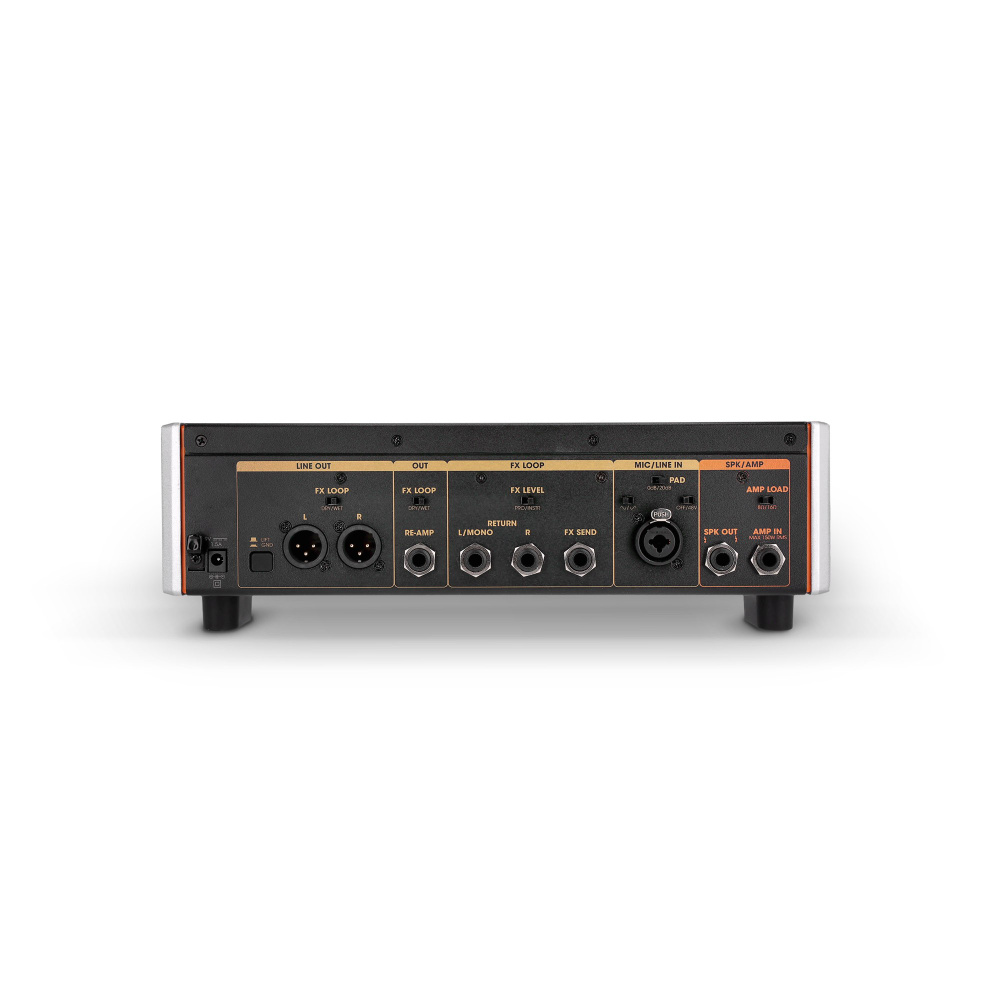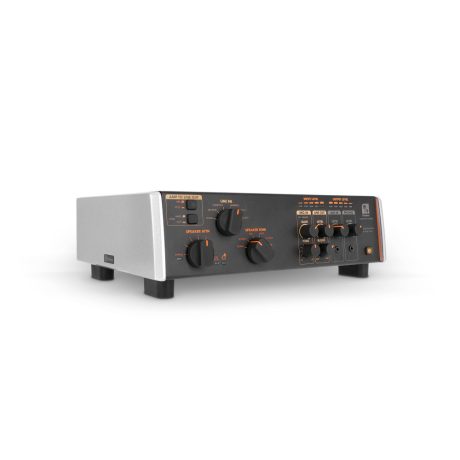| Content |
- Reactive attenuator and load box
- Finely-tuned analogue speaker simulator
- Speaker output with unique tone control
- Microphone / line input (blendable with speaker simulator)
- Front panel headphone output
- Stereo FX loop
- Front panel aux input
- Balanced stereo XLR Line Outputs
- Compatible with 8 and 16-ohm setups
- Rated for tube amps up to 150 Watts
- Amp protection circuit with permanent amp load
- All analogue experience; no app required!
General
Product type
attenuator, DI box, Headphone Amp:, load box, Microphone preamplifier, power soak, Re-amping device analogue, speaker simulator
Front panel controls
7-Step Speaker Attenuation, Aux In Level, Hard/Soft Tone Selector, Line EQ (5 Voicings), Line Out Blend, Line Out Level, Mic Gain, MIC Tone, Phone Level, Pre/Post Switch (Amp to Line Out), Speaker Tone (5 Voicings)
Rear panel controls
Amp Load Impedance Switch, FX Level (Pro/Instrument), FX Loop Line Out, FX Loop Re-Amp, GND/Lift, MIC/LINE Input PAD, Phantom Power, Polarity
Input type
Balanced, Unbalanced
Input connectors
3.5 mm jack, 6.3 mm jack, XLR
Output type
Balanced, Unbalanced
Output connectors
3.5 mm jack, 6.3 mm jack, XLR
Transformer isolated outputs
Yes
Internal load impedance
16 ohms, 8 ohms
Minimal load in OFF status
16 ohms
Voicing filter
5-step Speaker Tone and 5-step Line EQ
Indicators
bypass, Full attenuation, input level, MIC-Signal/Clip, Output level, power soak, thermal overload
Power supply
+ 9 V DC barrel jack - 1.5 A
Power supply polarity
Center negative
Power connector
2 x 5.5mm
Maximum power consumption
13.5 W
Standby power consumption
0.3 W
Dimensions (W x H x D)
334 x 108 x 274 mm
Ambient temperature (in operation)
- 20°C - 25 °C
Relative Humidity
< 80 % ( non-condensing )
Accessories (included)
Power supply
Audio inputs
AUX IN max. input level (< 1% THD, 1kHz)
+ 9 dBV
AMP IN max. input power
150 W Peak, 100 W RMS
Audio outputs
LINE OUT max. output level (<1% THD)
+ 18 dBu
RE-AMP max. output level (<1% THD)
+ 1.5 dBv
PHONES OUT max. output level (<1% THD, 1kHz)
1.4 V RMS
PHONES OUT min. impedance
33 Ohm
MIC / LINE Input
MIC / LINE IN low cut frequency (-3dB)
90 Hz
MIC / LINE IN Gain range
0 - 25 dB
MIC IN (XLR) max. input level (< 1% THD, 1kHz)
+ 1 dBu
LINE IN (TRS) max. input level (< 1% THD, 1kHz)
+ 22 dBu
MIC IN to LINE OUT THD+N (1kHz, +4dBu)
< 0.006 %
MIC IN to LINE OUT THD+N (20Hz-20kHz, +4dBu)
< 0,04 %
MIC IN to LINE OUT EIN (max. gain, unweighted)
- 114 dBu
MIC IN to LINE OUT SNR (all bypass)
105 dB
MIC/LINE IN PAD attenuation
20 dB
MIC IN (XLR) input impedance (balanced)
1500 Ohm(s)
LINE IN (TRS) input impedance (balanced)
24000 Ohm(s)
|
Δικάναλη κεφαλή με λυχνίες στα 30 Watts. Καθαρό κανάλι με απίστευτη διαύγεια και πεντακάθαρο λαμπερό ήχο, σε όλο το φάσμα των αρμονικών συχνοτήτων και σε οποιαδήποτε ένταση. Το δεύτερο (dirty) κανάλι διαθέτει το shape control ποτενσιόμετρο, το οποίο όχι μόνο είναι το πιο εύχρηστο ως προς την διαμόρφωση του ήχου, αλλά κάνει τον χαρακτηριστικό αυτόν ήχο της Orange που κυριολεκτικά ισοπεδώνει στις μεσαίες συχνότητες.
Μία απο τις πιο διαδεδομένες κεφαλές της Orange και όχι άδικα, αφού ο ήχος της είναι μοναδικός. Το τελικό αποτέλεσμα του ήχου που διαμορφώνεται με την τετράδα των λυχνιών EL84 που διαθέτει, μπορεί να χαρακτηριστεί το λιγότερο εντυπωσιακό. Το ξέσπασμα των λυχνιών καθώς οδηγούνται στο όριο του overdrive γίνεται αξεπέραστο. Δυνατότητα προσαρμογής του ενισχυτή με κλιμάκωση από 30, 15 ή 7 Watts αναλόγως των συνθηκών.
Χαρακτηριστικά :
- Ισχύς : 30, 15 ή 7 Watts
- Shape control, Dirty volume
- Δύο κανάλια
- 2 Band EQ (bass, treble) και gain control
- Foot switchable
- Power amp: 4 XEL84
- Preamp: 4 X ECC83/12AX7
- FX Loop: 1 X ECC81/12AT7
Διαστάσεις : 55 X 27 X 24 εκατοστά
Βάρος: 15.55 κιλά
|
Ενισχυτής κιθάρας HEAD Classic Plus 50 Watt, διαθέτει προενίσχυση με 4 λυχνίες 12AX7/ECC83 & έξοδο με 2 λυχνίες EL34B, 2 ανεξάρτητα κανάλια με reverb & FX-loop ελεγχόμενα από ποδοδιακόπτη, master volume, έξοδος balanced XLR και unbalanced 1/4" DI output.
Technical Info Power Output: 50 watts RMS into selectable 8 or 16-ohm loudspeaker load
Valve Complement: 4 x 12AX7/ECC83 (V1:Low microphonic) and 2 x EL34B
Dimensions (W x H x D): 702 x 265 x 285 mm / 27.6 x 10.4 x 11.2 in.
Weight: 22 kg / 48.5 lbs.
|
Marshall 1987X-01 50W Guitar Amplifier
Though the 50 Watt 1987X shares the same front and rear panel features as its big brother, the 1959 SLP, it does have its own distinct personality. Sweet warm singing sounds are packed into every nook and cranny of this great tone machine. As is the case with the 1959SLP, the 1987X has fittings and hardware as true to the originals as humanly possible, thus ensuring that authentic Marshall 'Vintage' look.
Highlights
Mix the two channels together by connecting a short, screened patch lead between the second input of Channel 1 and the first input of Channel 2. If you then plug your guitar into the first input of Channel 1, you can mix the different tonal characters of each channel for greater flexibility.
The Series Effects Loop features a true bypass switch that takes the loop completely out of the circuit, thus ensuring the original tone isn't compromised. The Level Switch allows you match the loop to either stompboxes or rack units.
- Output: 50 Watts
- Pre-amp Tubes: 3 x ECC83
- Power Amp Tubes: 2 x EL34
- EQ: 3-Band
- Presence Control
|
Marshall 1959HW 100W Guitar Amplifier
Historical, Tone and Tech Talk The 1959HW is a Class-A/B, all-valve, 100 Watt, two-channel head. When building this handwired re-issue of an amazing sounding, original Plexi head made in 1969, Marshall's goal was both obvious and simple: to make it as close to the original as possible in terms of components, circuitry, constructional methods, materials, specifications, ascetics, signal path, performance, tonal characteristics and feel. Marshall went to incredible lengths to achieve maximum authenticity and are delighted to report that their suppliers were equally as exacting in their tasks - none-more-so than their longtime partner, Dagnall Transformers.
As is now rock folklore, the 1959 came to be when The Who's guitarist, Pete Townshend, approached Marshall in the mid '60s and asked Jim to build him a 'weapon' that would allow him to play so loud that he wouldn't be able to hear what the members of the audience were saying, should they have the sheer audacity to talk whilst he was performing! Jim and his team obliged and within weeks of Pete's request one of rock's most instantly recognizable icons was born - the 100 Watt Marshall stack.
As Jim Marshall has already stated, the 1959 head first saw the light of day in late 1965 and was affectionately dubbed the Plexi because of the material used for its front panel. Although they continued to build 1959s, the now legendary Plexi-era came to an end in July 1969 when they started using gold anodized aluminum panels instead of Plexiglas. While all original Plexi 1959s are held in the highest esteem, several subtly different but tonally significant circuit variations existed the most celebrated and revered versions being those made between 1967 and 1969.
The circuit Marshall has revisited for the 1959HW boasts several of said 'tonally significant' variants when compared to the slightly later circuit Marshall uses for their critically acclaimed, standard-production Plexi re-issue the 1959SLP. The most sonically relevant technical departures in question lie in the negative feedback circuit. Where relevant, specific details concerning these 'deviations', and others, are inserted into the text labelled as 'Tonal Notes'.
As you can see from its front panel layout, the 1959HW is an extremely straightforward amplifier. Its two channels - Channel I and Channel II - each have two inputs (High and Low sensitivity) and separate Volume controls, while sharing the amplifier's four tone controls: Presence, Bass, Middle and Treble. Like all Marshall, all-valve amplifiers, the 1959 sounds at its very best when turned up full - and because of its conservative power rating and astonishing projection, is a formidable live amplifier in even the largest of venues. A truth its impressive history has proven time-and-time again, from the mid '60s to current day.
In keeping with its other non-master-volume, all-valve, Marshall brethren such as the JTM45 head and the 1962 'Bluesbreaker' combo, the 1959HW's aggressive yet sweetly distorted, harmonically rich, thick, musical tones result from its power valves being overdriven. As a result, when 'cranked' the 1959HW's instantly recognizable, guttural, 'punch you in the chest' roar is incredibly touch-sensitive, cleaning up or, if desired, sitting right on the edge of distortion when the guitar's volume is turned down. Not surprisingly, it responds well to picking dynamics too, indefatigably 'in-your-face' when you play like you really mean it and, once again, cleaning up as you pull back on your picking attack.
Technical Features
Valve compliment:Three ECC83s (12AX7s) in the pre-amp and a quartet of EL34 power valves working in push-pull. All valves are of the highest quality available and are subjected to meticulous grading and testing processes.
The way the three ECC83s (V1, V2 & V3) in the pre-amp are utilized is as follows:
V1 acts as the pre-amp gain stage for the High Treble and Normal channels - each half of the valve (the ECC83 being a dual-triode) acting as a dedicated gain stage for each channel.
V2 is common to both channels, which are passively summed before reaching this valve. The first half of V2 acts as a common second gain stage, boosting the combined signal, and then directly driving the second half of the valve which is configured as a cathode follower. The cathode follower is a unity gain device which acts as a buffer, providing a low impedance signal to drive the tone network.
Tonal Note 1:The second gain stage of the 1969 circuit they've faithfully reproduced boasts an extra cathode bypass capacitor which boosts upper-mids and top-end.
V3 acts as the amplifier's phase-splitter. This device divides the signal into two halves that are 180 degree out-of-phase with each other, and then feed the 1959's push-pull output stage.
Tone Circuit:In typical Marshall fashion, the shared tone network of this handwired 1959 re-issue is post gain, passive and interactive - the later simply meaning that the settings of the Bass and Treble controls affect the amount of mid-dip available via the Middle control.
Tonal Note 2:The Middle control is a 10% log pot, unlike the linear one found in the regular production 1959SLP. This greatly changes the dynamic of the whole tonal network and the interaction of its controls.
Components:Where possible they have gone back to the original suppliers for all components, to maintain the highest quality- including, as per the original, a U-clamp mounted choke as opposed to the fully shrouded, stand-up smoothing choke used in the majority of Marshall valve amplifiers. Also included is a custom-built 50μF single can, smoothing capacitor. These are just two examples of the many steps they have taken in order to ensure maximum authenticity.
Tag Boards:The tag boards used in your handwired re-issue is exactly the same as that in the original in terms of surface dimension, thickness and matrix pitch. The material they've using is made exclusively for Marshall and is registered with ULas ?Marshall EM42 brown.? The reason they didn't use a board with the exact same chemical composition as in the original units is because that material doesn't pass current safety legislation regarding flammability.
Transformers:As you are no doubt aware, the output and main transformers are vital components in an amplifier as they influence performance, sound and feel. Consequently, Marshall worked extremely closely with their associates in Dagnall's R&D department in order to duplicate the original transformers. To do this they spent a great deal of time and attention studying and analyzing the constructional methods and materials used in both transformers so they could match everything as closely as possible and also ensure that the all-important electrical characteristics and performance were identical.
Output Transformer:Just like the 1.5 in. original it is an exact replica of in terms of both performance and dimensions, the re-issue transformer is upright-mounting and sits entirely above the chassis. To be exact, this transformer is a C1998 which has a specification date of August 1967
Tonal Note 3:In the vast majority of Marshall valve amplifiers it is a standard design trait that the negative feedback (a circuit that drops the output impedance and thus controls the damping factor of the powerstage) applied around the amplifier is taken from the 8 Ohm tap on the output transformer. Doing this sets the power-amp up for a certain amount of damping that is independent of where you have the amplifier's impedance selector set. This means that, regardless of whether you use a 16, 8 or 4 Ohm cabinet, the damping on the speakers is the same.
This said, as is the case with quite a number of ?Plexi? era 100-watt heads, the negative feedback on the original 1969 circuit Marshall used for this reissue is taken off the actual speaker output itself. This means that the lower the impedance setting, the lower the damping factor - and the lower the damping factor is, the looser and more resonant the sound. Consequently, if you're using a 4 x 12 in. cabinet loaded with 16-ohm speakers that offers 16-ohm and 4-ohm mono inputs (eg: the Marshall 1960A, 1960B, 1960AV or 1960BV cabinets), the 4-ohm input will be looser and more resonant on the low end, while the 16-ohm input will be tighter and more controlled.
Not surprisingly, of the 'tonally significant' variants mentioned in this manual, this one is probably the most significant.
Mains (Power) Transformer: While the original transformer is large, the custom-made Dagnall reissue has been made even larger in order to satisfy strict, current-day safety legislation. Just like the original, the re-issue transformer is what is called a 'drop through, half-shroud', which sits horizontally as opposed to vertically. As with the output transformer, Marshall went to great lengths to ensure that its performance mirrors that of the original, paying particular attention to exactly replicating an effect called 'regulation' - which is the way that the voltage from the transformer that feeds the valve circuitry varies according to load. In terms of the concentric design and performance, this transformer embodies the performance of the 1203-80 original specification first drawn up for Marshall by Drake in February 1967. The original was a 2.5 in. transformer. Due to the aforementioned modern legislations, the reissue is 3 in..
Tonal Note 4:This circuit has the same filtering on the H.T. (high voltage DC, a.k.a. the B+ voltage) line as later versions, a factor that contributes to the 1959HW having a tighter sound than earlier versions.
Chassis:They are using a box-section chassis made from 16 gauge, mild steel with butt-welded corner joints. The steel is also passivated giving lifelong resistance to corrosion.
Marshall's original chassis has a lot of extra holes drilled in it that weren't used. No doubt these existed because the same exact chassis was also used for other products made at the time. The most noticeable 'extra hole' is one on top for a fourth ECC83 and on their reference unit, this particular hole has been covered up with a disc of steel that's been riveted into the two screw holes that would have been used to secure the valve holder, were it there. For the sake of authenticity they have copied all the holes on their reference chassis and have even duplicated the aforementioned circular steel cover!
Front Panel:Extra thick, gold colored Plexiglas (actually Perspex, causing some people to refer to it as 'Perplexi!') - exactly as the original. Specific details pertaining to the front panel features can be found on page 5 of this manual.
Rear Panel:Once again, gold Plexiglas - just like the original Marshall referenced.
Cabinet Construction:High-grade, flawless (knot-free) Baltic birch-ply with finger locked joints for maximum strength. The main cabinet frame (both sides, top and bottom) are 15mm ply, the front baffle is constructed from 12mm ply while the back of the cabinet is 9mm ply. All edges have a 15mm radius.
Cabinet Cosmetics:The 6 in. gold Marshall logo, black Levant covering, beading and piping model the look and style of the original.
|
Ζυγίζοντας λιγότερο από ένα κιλό, η Micro Terror είναι αναμφισβήτητα η πιο μικρή και φορητή κεφαλή στην αγορά. Όταν συνδυάζεται με την καμπίνα PPC108, μαζί με την aux είσοδο και την έξοδο ακουστικών που διαθέτει, την καθιστά ένα τέλειο ηχητικό αποτέλεσμα εξάσκησης και μελέτης. Ικανό, λόγω μεγέθους, να χωρέσει οπουδήποτε! Ωστόσο δεν πρέπει να θεωρηθεί ότι λόγω των παραχωρήσεων στον όγκο του, έχουν γίνει παραχωρήσεις και στην ποιότητα του. Το μόνο μικρό είναι το μέγεθος της κεφαλής και τίποτα άλλο.
Με ένα χαλύβδινο περίβλημα υψηλής αντοχής, η Micro Terror είναι κατασκευασμένη με τα ίδια υψηλά πρότυπα όπως και τα υπόλοιπο μοντέλα της οικογένειας Terror. Διαθέτει μια λυχνία 12AX7 / ECC81 στην προενίσχυση έτσι ώστε το βάθος του ήχου και ο όγκος του, να το κάνει πραγματικά συγκλονιστικό. Έτοιμη να αντεπεξέλθει σε συνθήκες εντάσεως και ποιότητας που η εικόνα της την αμφισβητεί! Μπορεί να χρησιμοποιηθεί με οποιοδήποτε ηχείο 8-16 Ohm.
Χαρακτηριστικά :
- Ισχύς : 20 Watts
- Τρόποι σύνδεσης καμπίνας: 1?8 ή 1?16 OHM (8 OHM το ελάχιστο)
- Μονοκάναλος με aux in
- Gain, tone, volume controls
- Λυχνίες: Preamp: 12AX7/ECC83
Διαστάσεις : 16.5 X 13.5 X 9.5 εκατοστά
Βάρος: 0.85 κιλά
|


















Αξιολογήσεις
Δεν υπάρχει καμία αξιολόγηση ακόμη.